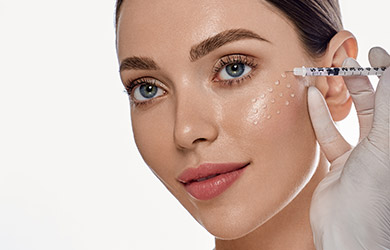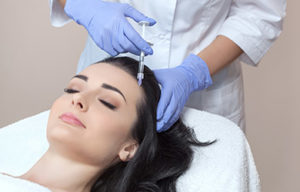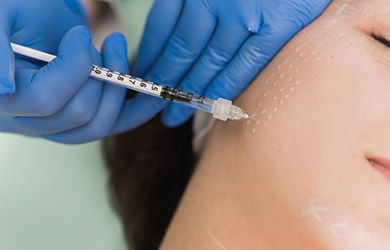

Mesotherapy is a minimally invasive cosmetic procedure that involves the injection of a customized cocktail of vitamins, minerals, and other pharmaceutical agents directly into the skin to address various aesthetic concerns. Nurse Kelly, in collaboration with Dr. Christoffersen at Cayman Doctors, offers mesotherapy as a safe and effective solution for individuals seeking rejuvenation and skin enhancement. With a focus on personalized care, Nurse Kelly and the medical team tailor each mesotherapy treatment to meet the unique needs and goals of their patients, promoting a natural and youthful appearance.
If you are seeking a solution for your skincare concerns, mesotherapy stands out as an innovative and personalized approach to address a range of issues. At Cayman Doctors, Nurse Kelly leads the way in providing expert mesotherapy treatments designed to target and rejuvenate your skin. Backed by a collaborative effort with Dr. Christoffersen, Nurse Kelly combines skill and precision to tailor each treatment to your specific needs, whether it’s diminishing fine lines, correcting uneven skin tone, or enhancing hydration.
To learn more about mesotherapy, please don’t hesitate to contact our clinic at 1 (345) 943-6363 to learn more about mesotherapy or book an . We are located at West Shore Center (Pink Plaza), 508 West Bay Road, PO Box 32078, Grand Cayman KY1-1208, Cayman Islands, B.W.I.
Discover the benefits of mesotherapy, individually curated by Nurse Kelly to unlock your skin’s full potential. Book a consultation with our expert team at Cayman Doctors, renowned for their high-level training and experience, to explore the ideal mesotherapy solution for your skin’s unique requirements.
Conveniently located on Seven Mile Beach, Grand Cayman
Fast Facts
Who’s it for?
Mesotherapy is suitable for individuals seeking targeted and personalized solutions for skincare concerns, including wrinkles, pigmentation issues, cellulite, and hair loss.
Similar products:
Dermal fillers, Platelet-Rich Plasma (PRP) therapy
Celebs who swear by it:
Katy Perry, Cara Delevingne, Jennifer Aniston and Rihanna
What is Mesotherapy?
Mesotherapy is a cosmetic procedure that originated in France in the 1950s. It involves the micro-injection of a tailored cocktail of substances into the mesoderm, the middle layer of the skin. This technique allows for precise and localized treatment of specific skin concerns, such as wrinkles, pigmentation issues, and hydration deficiencies.
How Mesotherapy Works

Mesotherapy works by delivering a personalized blend of vitamins, minerals, and other beneficial substances directly into the middle layer of the skin, known as the mesoderm. This is typically done through micro-injections. Once injected, these substances stimulate the skin cells, encouraging processes like increased collagen production, improved blood circulation, and enhanced cell metabolism. Think of it like giving your skin a tailored boost of nutrients precisely where it’s needed. This targeted approach helps rejuvenate the skin, addressing specific concerns such as wrinkles, pigmentation issues, and hydration deficiencies, resulting in a more refreshed and revitalized appearance.
Advantages of Mesotherapy
Mesotherapy offers the following advantages:
- Targeted Treatment: Mesotherapy allows for precise and localized treatment of specific skin concerns by delivering a customized blend of substances directly to the targeted areas.
- Minimally Invasive: As a non-surgical procedure, mesotherapy involves minimal discomfort and avoids the need for extensive incisions, reducing the risks associated with more invasive treatments.
- Versatility: Mesotherapy is versatile and can address a range of aesthetic issues, including fine lines, wrinkles, cellulite, and hair loss, making it applicable to various skincare goals.
- Highly Personalized: The treatment is highly personalized, with practitioners tailoring the injected substances to the individual’s unique skin needs, ensuring a customized approach for optimal results.
- Natural-Looking Results: Mesotherapy promotes natural-looking results by enhancing the skin’s health and appearance without drastic changes, contributing to a more youthful and refreshed look.
- Minimal Downtime: Compared to more invasive procedures, mesotherapy typically involves minimal downtime, allowing individuals to resume their daily activities shortly after the treatment.
- Increased Collagen Production: Mesotherapy stimulates collagen production, a key factor in maintaining skin elasticity and firmness, contributing to a more youthful complexion over time.
- Improved Blood Circulation: By enhancing blood circulation in the treated areas, mesotherapy supports the delivery of oxygen and nutrients to the skin cells, promoting overall skin health.
- Long-Lasting Effects: While multiple sessions may be recommended for optimal results, the effects of mesotherapy can be long-lasting, providing ongoing benefits to the skin’s appearance and health.
- Customizable for Various Skin Types: Mesotherapy can be adapted to suit different skin types and tones, making it a versatile option for individuals with diverse skincare needs.
What Brands Do We Use?
We take pride in the meticulous selection of brands that align with our commitment to excellence, and one such brand preferred by Nurse Kelly is Pluryal. Renowned for its extensive range of skincare solutions, Pluryal specializes in correcting various signs of skin aging, ensuring long-lasting and naturally beautiful results. Nurse Kelly specifically utilizes products from the Pluryal mesotherapy line, which have been expertly crafted to address the multifaceted challenges of aging skin. This line is designed not only to boost overall skin health but also to effectively diminish the appearance of facial wrinkles and replenish lost volume. The outcome is more radiant, glowing, and visibly younger-looking skin, making Pluryal a go-to choice for those seeking comprehensive skincare solutions.
Risks and Complications of Mesotherapy
While Mesotherapy is considered generally safe, as with any medical procedure, there exist potential risks, including bruising, swelling, and rare allergic reactions. Ensuring the procedure is conducted under the guidance of qualified and experienced practitioners is crucial to minimize the likelihood of complications. Nurse Kelly’s experience and collaboration with Dr. Christoffersen offers an added layer of assurance, significantly reducing the risk of adverse effects. Her expertise not only ensures the highest standard of care but also provides personalized attention to mitigate potential challenges, making the mesotherapy experience under her supervision a safer and more reliable choice for individuals seeking optimal results with minimized risks.
What to Expect Before Mesotherapy

Before undergoing mesotherapy, patients can expect a thorough consultation with our expert team. This includes a discussion of medical history, an examination of the targeted areas, and a comprehensive explanation of the procedure. Preparing for mesotherapy involves avoiding certain medications and adopting a skincare routine as advised by our professionals.
What to Expect During Mesotherapy
During the mesotherapy procedure, our commitment to patient comfort is paramount. To minimize any potential discomfort, our skilled practitioners employ advanced techniques, such as the application of numbing cream or, when necessary, the use of local anesthesia and Pro-nox (laughing gas). This meticulous approach enhances the overall experience for our patients. The targeted injections are administered with precision and the entire process is efficiently completed within a short timeframe.
Mesotherapy Recovery Time
One of the advantages of mesotherapy, including the specialized treatments provided by Nurse Kelly, is its minimal downtime. Most patients can resume their daily activities immediately after the procedure. Some may experience mild redness or swelling, which typically subsides within a short period. Nurse Kelly’s expertise ensures not only a swift recovery but also a personalized approach to address individual skincare needs.
Conditions Treated by Mesotherapy
Mesotherapy effectively addresses a variety of skin concerns. From reducing the appearance of wrinkles and fine lines to tackling cellulite and promoting hair growth, this versatile treatment has been employed successfully in dermatology and aesthetic medicine.
Fine Lines and Wrinkles
Mesotherapy effectively treats fine lines and wrinkles by delivering a customized blend of vitamins, minerals, and other beneficial substances directly into the skin’s mesoderm layer through micro-injections. This targeted approach stimulates collagen production, a crucial protein for maintaining skin elasticity and reducing the appearance of fine lines. Additionally, the injected substances promote improved hydration and blood circulation, contributing to smoother and more youthful-looking skin.
A study assessed the clinical impact of mesotherapy on periorbital wrinkles (fine lines and creases that form around the outer corners of the eyes) and examined skin changes resulting from the treatment. [1] Six volunteers with Fitzpatrick skin types III or IV and Glogau class I–III wrinkles underwent a three-month mesotherapy course, receiving six sessions at two-week intervals. Standard photographs and skin biopsies were collected at baseline, end of treatment, and three months post-treatment. Results showed an increase in collagen types I, III, and VII, newly synthesized collagen, total elastin, and tropoelastin.
A study evaluated the efficacy, safety, and subject satisfaction of combining non–cross-linked hyaluronic acid (HA) compound filling with mesotherapy for the correction of horizontal neck lines, comparing it with botulinum toxin A (BTX-A). [2] In this study, female patients with moderate-to-severe neck lines received either 2 or 3 sessions of non–cross-linked HA compound filling plus mesotherapy or 1 session of BTX-A injection. Results showed that the combined treatment significantly improved horizontal neck lines grades compared to BTX-A, with consistent outcomes across different baseline grades. Global Aesthetic Improvement Scale (GAIS) and patient satisfaction ratings were notably higher for the HA filling plus mesotherapy group. No serious adverse events were reported, suggesting that combined treatment offers significant improvement and high patient satisfaction for moderate-to-severe horizontal neck lines.
In a study involving thirty-four volunteers, the subjects were randomly assigned to control and treatment groups. [3] The control group received medical hyaluronic acid gel while the treatment group received medical dextrose tincture during three mesotherapy sessions with a 28-day interval. Video image acquisition and various skin tests were conducted before and 28 days after treatment, assessing skin moisture content, glossiness, heme content, collagen density, and elasticity. Results demonstrated that medical dextran tincture significantly increased skin moisture retention, gloss, and collagen density while reducing skin retraction time. These effects were more pronounced compared to medical hyaluronic acid gel. Both doctor and volunteer subjective evaluations indicated substantial improvements in overall skin photoaging scores and various skin problems, respectively, highlighting the moisturizing, luster-enhancing, and collagen-boosting effects of medical dextran tincture.
Treatment Options
Mesotherapy treats fine lines and wrinkles by delivering a personalized blend of vitamins, minerals, and other beneficial substances directly into the skin, stimulating collagen production and improving skin elasticity for a rejuvenated appearance.
Hyperpigmentation
Mesotherapy can treat hyperpigmentation by delivering a customized mixture of vitamins, minerals, and amino acids directly into the skin, promoting cellular repair and regeneration. The cocktail of nutrients helps to regulate melanin production, reducing excess pigmentation and promoting a more even skin tone. The targeted delivery of these ingredients through mesotherapy can enhance the effectiveness of the treatment for hyperpigmentation.
In one study, five patients with pigmented gingiva (gums) in the maxillary (upper jaw) or mandibular anterior (front part of the lower jaw) region underwent a series of locally injectable vitamin C treatments once a week for 4 to 5 sessions. [4] The efficacy of the depigmentation was assessed using the Dummett Oral Pigmentation Index (DOPI) and Gingival Pigmentation Index (GPI), along with measures such as gingival luminescence (L*) and pigmented surface area (PSA) based on digital photographs. Results showed significant reductions in GPI, DOPI, and PSA at 1 month, with no significant change from 1 to 3 months. The L* value increased significantly and patients reported minimal pain, favorable gingival color changes, and high overall satisfaction, suggesting that oral mesotherapy with locally injectable vitamin C is an effective, minimally invasive technique for gingival depigmentation.
In a clinical trial involving 30 patients at Dermatology Clinics, melasma (brown or grayish-brown facial patches) therapy was conducted using two different cocktails (A and B) with the mesotherapy technique. [5] Cocktail A included tranexamic acid (TA), vitamin C, and glutathione, while Cocktail B consisted of TA and vitamin C. Both cocktails were applied to different halves of the patients’ faces for six sessions at 2-week intervals. The modified Melasma Area and Severity Scoring (mMASI) were assessed at the beginning and end of the study. Results showed that both cocktails significantly reduced the mMASI score on each side, with Cocktail A demonstrating a greater reduction compared to Cocktail B. Erythema (redness), edema (swelling), and ecchymosis (bruising) were not significantly different between the two cocktails. The study concludes that combination mesotherapy is effective in treating melasma, with Cocktail A, containing glutathione, yielding superior results compared to Cocktail B.
In another study, twenty healthy non-smokers with hyperpigmented gingiva were randomly assigned to receive either mesotherapy (G1) with intra-mucosal injection of ascorbic acid once a week for three weeks, or Gel (G2) with topical ascorbic acid gel applied once daily for three months. [6] Evaluations including the pigmentation index (DOPI), patient satisfaction, and histological analysis were conducted at baseline and after 6 months. Results revealed that the median DOPI significantly decreased after 1 month in G1, with a higher satisfaction level compared to G2. Both treatments led to a reduction in the mean area fraction of melanin-forming cells after 6 months, but the effect size was greater in G1 than in G2. The study concludes that vitamin C mesotherapy demonstrated superior and quicker results compared to the topical gel, with both techniques being painless and aesthetically satisfying for managing gingival hyperpigmentation.
Treatment Options
Mesotherapy can treat hyperpigmentation by delivering a customized blend of vitamins, minerals, and amino acids directly into the skin, regulating melanin production and promoting cellular repair for a more even skin tone.
Cellulite
Cellulite is a condition characterized by the appearance of dimpled or lumpy skin, usually on the buttocks, thighs, and hips, caused by the protrusion of fat deposits into the connective tissue beneath the skin. It is more common in women and can be influenced by factors such as genetics, hormonal changes, and a sedentary lifestyle. Its appearance is largely influenced by the structure of connective tissue and the distribution of fat in the body.
Mesotherapy can treat cellulite by injecting a combination of pharmaceutical agents, vitamins, and minerals into the subcutaneous tissue (beneath the skin), targeting the underlying causes of cellulite such as excess fat and poor blood circulation. The injections help break down fat cells, improve blood flow, and stimulate collagen production, leading to smoother skin texture and reduced cellulite appearance. Mesotherapy is often used as a non-invasive and localized approach to address cellulite, promoting contouring and skin tightening.
A study evaluated the effectiveness of intradermal mesotherapy for reducing cellulite, utilizing both conventional and high-frequency ultrasound. [7] Twenty-one women with cellulite underwent intradermal mesotherapy and skin assessments were conducted. Additionally, measurements of thigh circumference, body mass index, and cellulite severity were conducted using Nürnberger-Müller’s scale. Results showed a significant reduction in cellulite severity, surface area of the hypodermis-dermis junction, and hypodermis thickness. Palpation, decreased thigh circumference, and Nürnberger-Müller’s grade further confirmed cellulite reduction.
A study evaluated the lipolytic (fat loss) potential of solutions used in the practice of cosmetic mesotherapy to stimulate lipolysis (fat breakdown), cause local fat reduction, and reduce the appearance of cellulite. [8] The mesotherapy solutions were tested in a human fat cell sample using the fold induction of glycerol generation as a measure of lipolysis. The following mesotherapy solutions were tested: aminophylline; yohimbine; isoproterenol; melilotus; aminophylline with melilotus; aminophylline with isoproterenol; aminophylline with isoproterenol and yohimbine; aminophylline with isoproterenol and lidocaine; and aminophylline with isoproterenol, yohimbine and lidocaine. Isoproterenol, aminophylline, and yohimbine stimulated lipolysis compared to the buffer control. The lipolysis stimulated by melilotus and isoproterenol was enhanced by aminophylline. The lipolytic stimulation by aminophylline and isoproterenol and by aminophylline and isoproterenol with yohimbine was inhibited by lidocaine, not significant compared to buffer control for aminophylline and isoproterenol, but aminophylline, isoproterenol and yohimbine still stimulated lipolysis more than control. Isoproterenol, aminophylline, yohimbine and melilotus stimulate lipolysis alone, and lipolysis is further enhanced by combining lipolytic stimulators in mesotherapy solutions.
Treatment Options
Mesotherapy treats cellulite by injecting a combination of pharmaceuticals, vitamins, and other substances directly into the mesoderm (middle layer of skin), promoting localized fat reduction, improved blood flow, and collagen production for a smoother appearance.
Hair Loss
Mesotherapy treats hair loss by injecting a customized blend of vitamins, minerals, amino acids, and growth factors directly into the scalp, stimulating hair follicles and promoting hair growth. The microinjections enhance blood circulation, delivering essential nutrients to the hair follicles and reducing inflammation, which can contribute to hair loss. This targeted approach revitalizes the scalp, strengthens existing hair, and encourages the growth of new, healthier hair strands.
A study outlined the safety profile of mesotherapy using dutasteride in real clinical settings for patients with androgenetic alopecia (gradual hair loss influenced by genetic and hormonal factors), with a secondary focus on assessing treatment effectiveness. [9] The study included 541 patients with at least 6 months of follow-up. Results showed that the common practice was to administer the treatment every 3 months during the first year. Out of 86 patients assessed after one year, the majority showed clinical improvement, with 33 experiencing marked improvement. Pain was the most prevalent side effect (45.5%), but it was generally mild and self-limited. No serious or sexual adverse events were observed, leading to the conclusion that mesotherapy with dutasteride is an effective and well-tolerated option for both male and female hair loss in real clinical practice, particularly for patients seeking alternatives to oral treatments.
In a clinical trial, 49 clinically diagnosed males with androgenetic alopecia (AGA) were divided into two groups: mesotherapy (Group A, 25 participants) and minoxidil (Group B, 24 participants). [10] Group A received eight sessions of intralesional mesosolution with microneedling, while Group B applied topical minoxidil 5% twice daily for 4 months. Evaluations using clinical photographs, dermoscopy (a non-invasive diagnostic technique that involves examining skin lesions using a handheld device), trichoscan (utilizes specialized imaging technology to assess and analyze hair and scalp conditions), a 7-point standard assessment tool, and patient self-assessment scores were conducted at baseline and monthly for 4 months. The most common presentation was Grade II. Dermoscopic parameters showed no significant differences between groups, except for a significant increase in the variation of hair shaft diameter between pre- and post-treatment in Group A compared to Group B. Overall, the study suggests that mesotherapy does not exhibit a significant improvement over minoxidil in treating male AGA but may help increase hair shaft diameter.
Question & Answer
What substances are typically used in mesotherapy injections?
Mesotherapy injections may contain a mix of vitamins, minerals, amino acids, hyaluronic acid, and medications, tailored to address specific concerns and conditions.
Is mesotherapy a painful procedure?
Discomfort during mesotherapy is generally minimal, and topical anesthetics can be applied to minimize any pain associated with the injections.
How long does a mesotherapy session typically last?
A mesotherapy session usually takes about 30 minutes to an hour, depending on the area being treated and the specific protocol.
How many mesotherapy sessions are typically required for noticeable results?
The number of sessions varies based on the condition being treated. For some conditions, a series of sessions spaced over weeks or months may be recommended.
Are there any side effects of mesotherapy?
Common side effects include temporary swelling, bruising, and redness at the injection site. Serious complications are rare when the procedure is performed by a qualified professional.
Who is a suitable candidate for mesotherapy?
Suitable candidates for mesotherapy vary depending on the condition being treated. A consultation with a qualified healthcare professional can determine individual eligibility.
How long do the results of mesotherapy last?
The duration of results varies based on the treated condition. Maintenance sessions may be recommended to sustain and enhance the effects.
Can mesotherapy be combined with other cosmetic procedures?
Depending on the individual’s goals and circumstances, mesotherapy may be combined with other cosmetic procedures for a comprehensive approach to treatment.
References
- El-Domyati M, El-Ammawi TS, Moawad O, El-Fakahany H, Medhat W, Mahoney MG, Uitto J. Efficacy of mesotherapy in facial rejuvenation: a histological and immunohistochemical evaluation. Int J Dermatol. 2012 Aug;51(8):913-9. doi: 10.1111/j.1365-4632.2011.05184.x. PMID: 22788806; PMCID: PMC3513770. Retrieved from https://www.ncbi.nlm.nih.gov/pmc/articles/PMC3513770/.
- Li Y, Liao M, Zhu Y, Gao J, Song Y, Zhai Y, Zhu M, He Y, Dong W. Hyaluronic Acid Compound Filling Plus Mesotherapy vs Botulinum Toxin A for the Treatment of Horizontal Neck Lines: A Multicenter, Randomized, Evaluator-Blinded, Prospective Study in Chinese Subjects. Aesthet Surg J. 2022 Mar 15;42(4):NP230-NP241. doi: 10.1093/asj/sjab387. Erratum in: Aesthet Surg J. 2022 Apr 02;: PMID: 34758056; PMCID: PMC8972830. Retrieved from https://www.ncbi.nlm.nih.gov/pmc/articles/PMC8972830/.
- Song Y, Liu Q, Zhang Y, Zhang H, Li B. Clinical Efficacy of Medical Dextrose Tincture Liquid in the Treatment of Facial Photoaging. Dermatol Pract Concept. 2023 Jan 1;13(1):e2023015. doi: 10.5826/dpc.1301a15. PMID: 36892373; PMCID: PMC9946104. Retrieved from https://www.ncbi.nlm.nih.gov/pmc/articles/PMC9946104/.
- Dawar A, Kamra P, Anand D, Nayyar V, Mishra D, Pandey S. Oral mesotherapy technique for the treatment of physiologic gingival melanin hyperpigmentation using locally injectable vitamin C: a clinical and histologic cases series. Quintessence Int. 2022 Jun 20;53(7):580-588. doi: 10.3290/j.qi.b3044857. PMID: 35674171. Retrieved from https://pubmed.ncbi.nlm.nih.gov/30735611/.
- Iraji F, Nasimi M, Asilian A, Faghihi G, Mozafarpoor S, Hafezi H. Efficacy of mesotherapy with tranexamic acid and ascorbic acid with and without glutathione in treatment of melasma: A split face comparative trial. J Cosmet Dermatol. 2019 Oct;18(5):1416-1421. doi: 10.1111/jocd.12874. Epub 2019 Feb 8. PMID: 30735611. Retrieved from https://pubmed.ncbi.nlm.nih.gov/30735611/.
- El-Mofty M, Elkot S, Ghoneim A, Yossri D, Ezzatt OM. Vitamin C mesotherapy versus topical application for gingival hyperpigmentation: a clinical and histopathological study. Clin Oral Investig. 2021 Dec;25(12):6881-6889. doi: 10.1007/s00784-021-03978-6. Epub 2021 May 8. Erratum in: Clin Oral Investig. 2021 Aug 2;: PMID: 33966113. Retrieved from https://pubmed.ncbi.nlm.nih.gov/33966113/.
- Sylwia M, Krzysztof MR. Efficacy of intradermal mesotherapy in cellulite reduction – Conventional and high-frequency ultrasound monitoring results. J Cosmet Laser Ther. 2017 Oct;19(6):320-324. doi: 10.1080/14764172.2017.1334927. Epub 2017 Jun 7. PMID: 28590783. Retrieved from https://pubmed.ncbi.nlm.nih.gov/28590783/.
- Caruso MK, Roberts AT, Bissoon L, Self KS, Guillot TS, Greenway FL. An evaluation of mesotherapy solutions for inducing lipolysis and treating cellulite. J Plast Reconstr Aesthet Surg. 2008 Nov;61(11):1321-4. doi: 10.1016/j.bjps.2007.03.039. Epub 2007 Oct 22. PMID: 17954040. Retrieved from https://pubmed.ncbi.nlm.nih.gov/17954040/.
- Saceda-Corralo D, Moustafa F, Moreno-Arrones Ó, Jaén-Olasolo P, Vañó-Galván S, Camacho F. Mesotherapy With Dutasteride for Androgenetic Alopecia: A Retrospective Study in Real Clinical Practice. J Drugs Dermatol. 2022 Jul 1;21(7):742-747. doi: 10.36849/JDD.6610. PMID: 35816059. Retrieved from https://pubmed.ncbi.nlm.nih.gov/35816059/.
- Gajjar PC, Mehta HH, Barvaliya M, Sonagra B. Comparative Study between Mesotherapy and Topical 5% Minoxidil by Dermoscopic Evaluation for Androgenic Alopecia in Male: A Randomized Controlled Trial. Int J Trichology. 2019 Mar-Apr;11(2):58-67. doi: 10.4103/ijt.ijt_89_18. PMID: 31007474; PMCID: PMC6463458. Retrieved from https://www.ncbi.nlm.nih.gov/pmc/articles/PMC6463458/.




 HOW TO LOOK YOUR BEST
HOW TO LOOK YOUR BEST